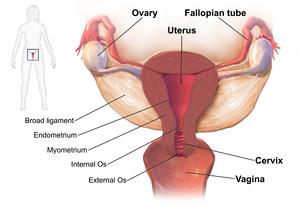Pelvic inflammatory disease, also known as pelvic inflammatory disorder (PID), is an infection of the upper part of the female reproductive system, namely the uterus, fallopian tubes, and ovaries, and inside of the pelvis. Often, there may be no symptoms. Signs and symptoms, when present, may include lower abdominal pain, vaginal discharge, fever, burning with urination, pain with sex, bleeding after sex, or irregular menstruation. Untreated PID can result in long-term complications including infertility, ectopic pregnancy, chronic pelvic pain, and cancer. The disease is caused by bacteria that spread from the vagina and cervix. Infections by Neisseria gonorrhoeae or Chlamydia trachomatis are present in 75 to 90 percent of cases. Often, multiple different bacteria are involved. Without treatment, about 10 percent of those with a chlamydial infection and 40 percent of those with a gonorrhea infection will develop PID. Risk factors are generally similar to those of sexually transmitted infections and include a high number of sexual partners and drug use. Vaginal douching may also increase the risk. The diagnosis is typically based on the presenting signs and symptoms. It is recommended that the disease be considered in all women of childbearing age who have lower abdominal pain. A definitive diagnosis of PID is made by finding pus involving the fallopian tubes during surgery. Ultrasound may also be useful in diagnosis. Efforts to prevent the disease include not having sex or having few sexual partners and using condoms. Screening women at risk for chlamydial infection followed by treatment decreases the risk of PID. If the diagnosis is suspected, treatment is typically advised. Treating a woman's sexual partners should also occur. In those with mild or moderate symptoms, a single injection of the antibiotic ceftriaxone along with two weeks of doxycycline and possibly metronidazole by mouth is recommended. For those who do not improve after three days or who have severe disease, intravenous antibiotics should be used. Globally, about 106 million cases of chlamydia and 106 million cases of gonorrhea occurred in 2008. The number of cases of PID, however, is not clear. It is estimated to affect about 1.5 percent of young women yearly. In the United States, PID is estimated to affect about one million people each year. A type of intrauterine device (IUD) known as the Dalkon shield led to increased rates of PID in the 1970s. Current IUDs are not associated with this problem after the first month.

Icd10
-
N70.
N77.
Icd9
-
Mesh id
D000292



Comment
0